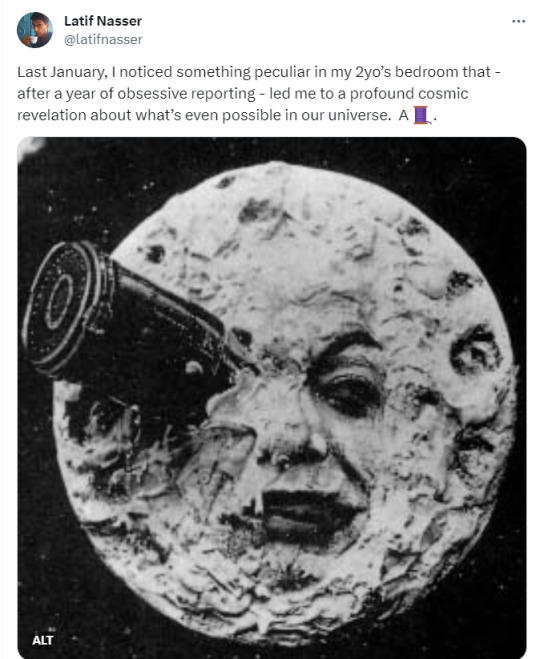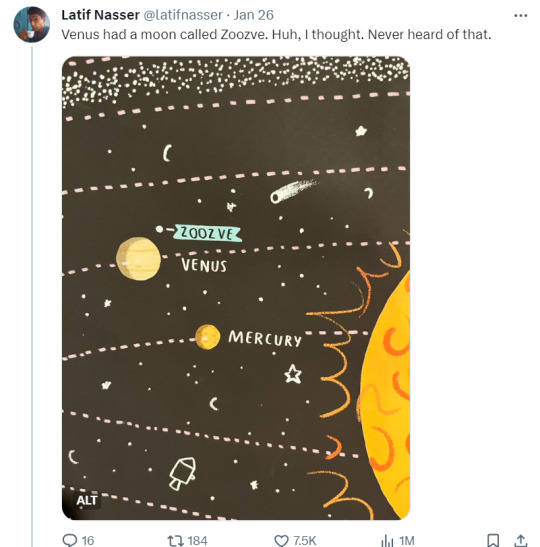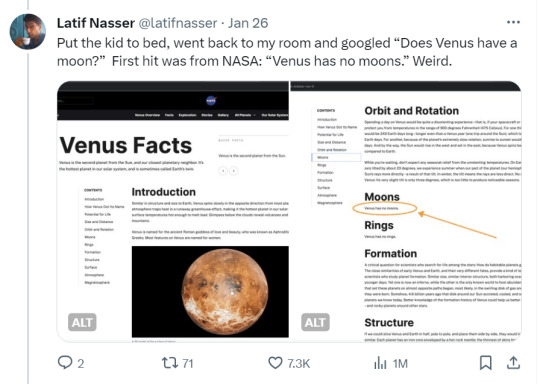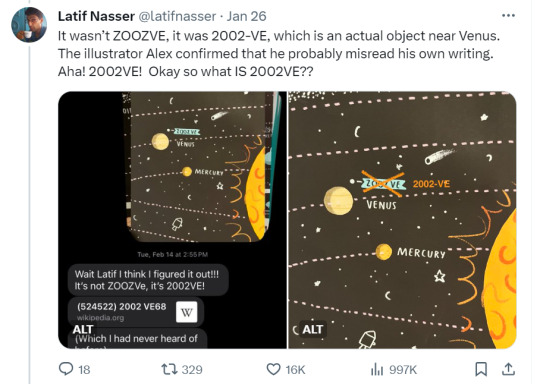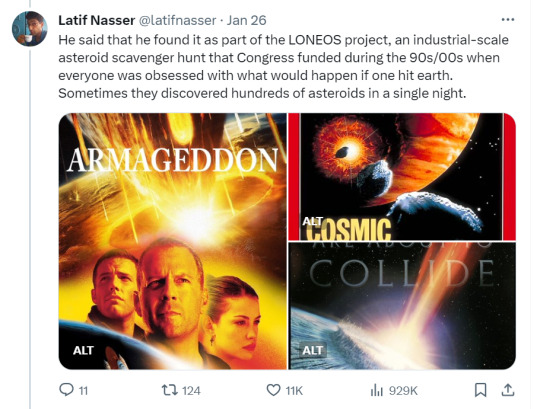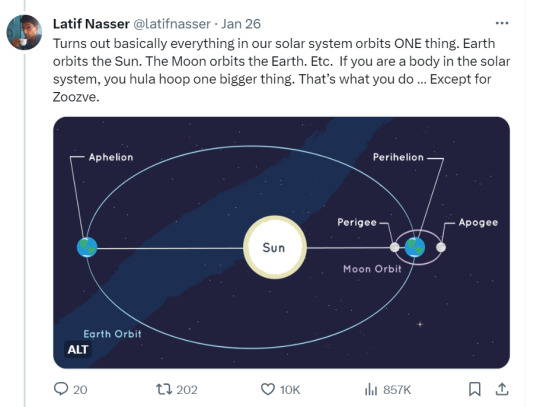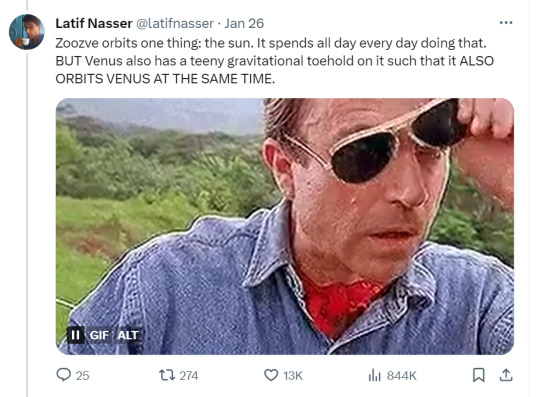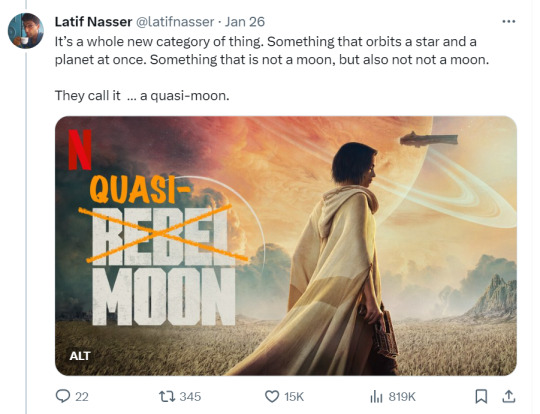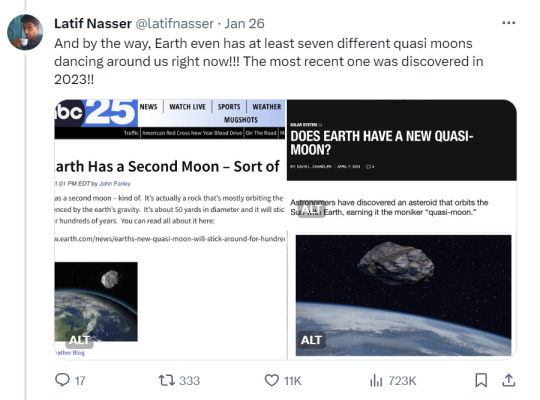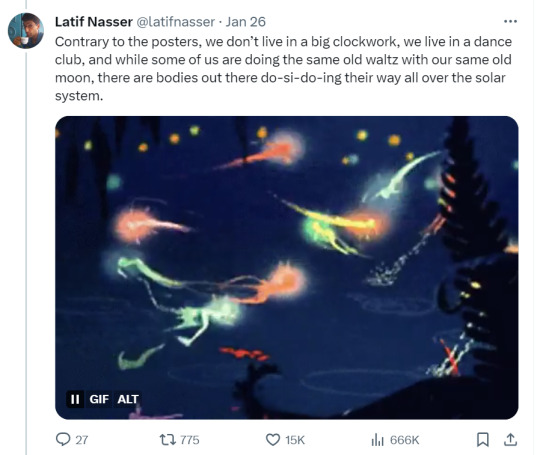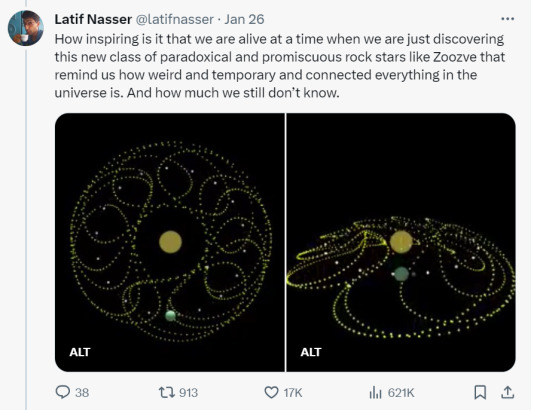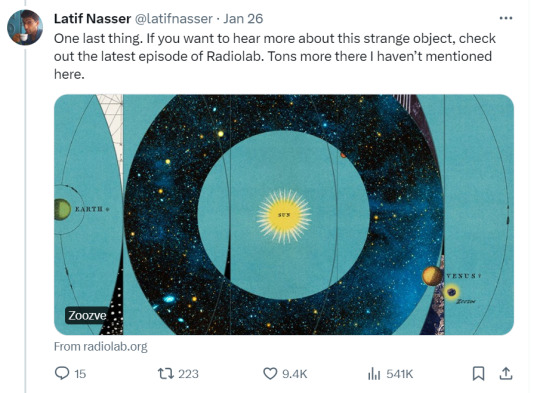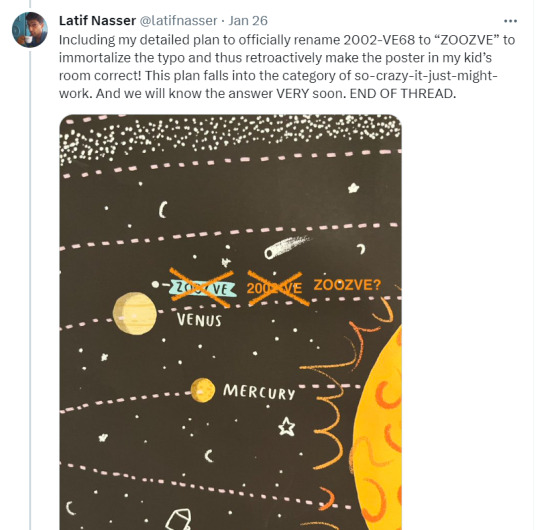Text
Y'all, the world is sleeping on what NASA just pulled off with Voyager 1
The probe has been sending gibberish science data back to Earth, and scientists feared it was just the probe finally dying. You know, after working for 50 GODDAMN YEARS and LEAVING THE GODDAMN SOLAR SYSTEM and STILL CHURNING OUT GODDAMN DATA.
So they analyzed the gibberish and realized that in it was a total readout of EVERYTHING ON THE PROBE. Data, the programming, hardware specs and status, everything. They realized that one of the chips was malfunctioning.
So what do you do when your probe is 22 Billion km away and needs a fix? Why, you just REPROGRAM THAT ENTIRE GODDAMN THING. Told it to avoid the bad chip, store the data elsewhere.
Sent the new code on April 18th. Got a response on April 20th - yeah, it's so far away that it took that long just to transmit.
And the probe is working again.
From a programmer's perspective, that may be the most fucking impressive thing I have ever heard.
92K notes
·
View notes
Text
Scientists have known that the giant plume of ice grains and water vapor spewing from Saturn’s moon Enceladus is rich with organic compounds, some of which are important for life as we know it. Now, scientists analyzing data from NASA’s Cassini mission are taking the evidence for habitability a step further: They’ve found strong confirmation of hydrogen cyanide, a molecule that is key to the origin of life.
The researchers also uncovered evidence that the ocean, which is hiding below the moon’s icy outer shell and supplies the plume, holds a powerful source of chemical energy. Unidentified until now, the energy source is in the form of several organic compounds, some of which, on Earth, serve as fuel for organisms.
0 notes
Text
We live in an age of exoplanet discovery. One thing we’ve learned is not to be surprised by the kinds of exoplanets we keep discovering. We’ve discovered planets where it might rain glass or even iron, planets that are the rocky core remnants of gas giants stripped of their atmospheres, and drifting rogue planets untethered to any star.
Now, astronomers have uncovered evidence of an exoplanet in a circumbinary disk around a binary star. The remarkable thing about this discovery is that the disk is in a polar configuration. That means the exoplanet moves around its binary star in a circumpolar orbit, and this is the first one scientists have found.
AC Herculis (AC Her) is a binary star about 4200 light-years away. The primary star is well-studied, while its partner is invisible. It has a polar circumbinary disk, which is unusual but not unheard of. In a new paper, a team of researchers presents evidence for the polar circumbinary exoplanet.
0 notes
Photo
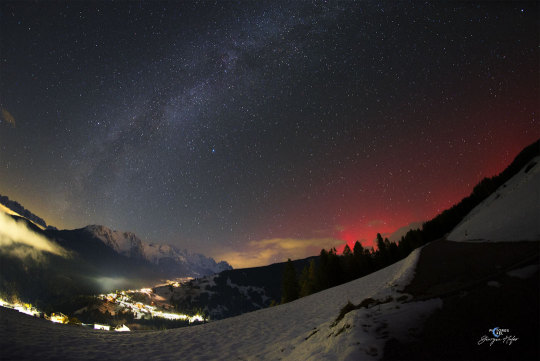
2023 November 6
Red Aurora over Italy
Image Credit & Copyright: Giorgia Hofer
Explanation: What was that red glow on the horizon last night? Aurora. Our unusually active Sun produced a surface explosion a few days ago that sent out a burst of electrons, protons, and more massive charged nuclei. This coronal mass ejection (CME) triggered auroras here on Earth that are being reported unusually far south in Earth’s northern hemisphere. For example, this was the first time that the astrophotographer captured aurora from her home country of Italy. Additionally, many images from these auroras appear quite red in color. In the featured image, the town of Comelico Superiore in the Italian Alps is visible in the foreground, with the central band of our Milky Way galaxy seen rising from the lower left. What draws the eye the most, though, is the bright red aurora on the far right. The featured image is a composite with the foreground and background images taken consecutively with the same camera and from the same location.
∞ Source: apod.nasa.gov/apod/ap231106.html
77 notes
·
View notes
Text
Plunge into the darker side of the night sky, and get to know dark nebulae. Dark nebulae – or absorption nebulae – are clouds of gas and dust in space that are dense enough to obscure and block light from background stars. These vast clouds are mostly composed of molecular hydrogen. Often, they are locations where material is coalescing to form new stars. American astronomer Edward Emerson Barnard was the first to create a large catalog of 182 dark nebulae in the year 1919. Since then, hundreds more have been found and charted in our Milky Way galaxy.
0 notes
Photo

2023 November 5
Creature Aurora Over Norway
Image Credit & Copyright: Ole C. Salomonsen (Arctic Light Photo)
Explanation: It was Halloween and the sky looked like a creature. Exactly which creature, the astrophotographer was unsure (but possibly you can suggest one). Exactly what caused this eerie apparition in 2013 was sure: one of the best auroral displays that year. This spectacular aurora had an unusually high degree of detail. Pictured here, the vivid green and purple auroral colors are caused by high atmospheric oxygen and nitrogen reacting to a burst of incoming electrons. Birch trees in Tromsø, Norway formed an also eerie foreground. Frequently, new photogenic auroras accompany new geomagnetic storms.
∞ Source: apod.nasa.gov/apod/ap231105.html
152 notes
·
View notes
Text
Last September, NASA purposefully smashed a spacecraft into Dimorphos, a 160m-wide space rock orbiting a larger asteroid named Didymos. The goal of the mission, called DART (the Double Asteroid Redirection Test), was to demonstrate humanity’s ability to redirect hazardous asteroids away from Earth. That part of the mission was a success above and beyond all expectations. But now scientists are also learning more about the origins of the two asteroids. A study conducted in the wake of the DART impact found that Dimorphos is made from the same material as Didymos, and that the pair of asteroids likely originated from a single body.
0 notes
Photo

2023 November 4
Dinkinesh Moonrise
Image Credit: NASA/Goddard, SwRI, Johns Hopkins APL, NOIRLab
Explanation: Last Wednesday the voyaging Lucy spacecraft encountered its first asteroid, 152830 Dinkinesh, and discovered the inner-main belt asteroid has a moon. From a distance of just over 400 kilometers, Lucy’s Long-Range Reconnaissance Imager captured this close-up of the binary system during a flyby at 4.5 kilometer per second or around 10,000 miles per hour. A marvelous world, Dinkinesh itself is small, less than 800 meters (about 0.5 miles) across at its widest. Its satellite is seen from the spacecraft’s perspective to emerge from behind the primary asteroid. The asteroid moon is estimated to be only about 220 meters wide.
∞ Source: apod.nasa.gov/apod/ap231104.html
149 notes
·
View notes
Text
A recent solar storm smashed into Earth and created what appeared to be bright pumpkin-colored pillars dancing in the night sky above Canada, a haunting new photo reveals. But there is a problem with the image: Orange-colored auroras should not exist.
Instead of impossible auroras, the image actually captured a rare mix of red and green lights that hasn't been this visible since a monstrous Halloween solar storm smashed into Earth 20 years ago, experts say.
1 note
·
View note
Photo

2023 November 3
Jupiter by Moonlight
Image Credit & Copyright: Giorgia Hofer
Explanation: That bright beacon you’ve seen rising in the east just after sunset is Jupiter. Climbing high in midnight skies, our Solar System’s ruling gas giant was at its 2023 opposition, opposite the Sun in planet Earth’s sky, on November 2. But only a few days earlier, on October 28, the Moon was at its own opposition. Then both Full Moon and Jupiter could share this telephoto field of view. The celestial scene is composed from two exposures, one long and one short, blended to record bright planet and even brighter Moon during that evening’s partial lunar eclipse. Moonlight shining through the thin, high clouds over northern Italy creates the colorful iridescence and lunar corona. Look closely and you’ll also spot some of Jupiter’s Galilean moons.
∞ Source: apod.nasa.gov/apod/ap231103.html
181 notes
·
View notes
Text
Posted on November 2, 2023 by Evan Gough
Old Data from Kepler Turns Up A System with Seven Planets
NASA’s Kepler mission ended in 2018 after more than nine years of fruitful planet-hunting. The space telescope discovered thousands of planets, many of which bear its name. But it also generated an enormous amount of data that exoplanet scientists are still analyzing.
Now, a team of researchers has shed new light on a seven-planet system in Kepler’s ocean of data.
The star is called Kepler 385, and it’s about 4,670 light-years away. Some of its planets were confirmed back in 2014, while some remained as candidates. But in a new updated catalogue, exoplanet scientists have confirmed the rest of the planets and revealed new details on this rare system.
0 notes
Text
This newly released image from the NASA Hubble Space Telescope shows the planet Jupiter in a color composite of ultraviolet wavelengths. Released in honor of Jupiter reaching opposition, which occurs when the planet and the Sun are in opposite sides of the sky, this view of the gas giant planet includes the iconic, massive storm called the “Great Red Spot.” Though the storm appears red to the human eye, in this ultraviolet image it appears darker because high altitude haze particles absorb light at these wavelengths. The reddish, wavy polar hazes are absorbing slightly less of this light due to differences in either particle size, composition, or altitude.
The data used to create this ultraviolet image is part of a Hubble proposal that looked at Jupiter’s stealthy superstorm system. The researchers plan to map deep water clouds using the Hubble data to define 3D cloud structures in Jupiter’s atmosphere.
0 notes
Text
A comet discovered earlier this year is performing above expectations, and is currently well-placed in the dusk sky. We’re talking about Comet C/2023 H2 Lemmon, moving up the charts now at magnitude +8 and brightening.
The first half of November is the best time to catch comet H2 Lemmon. The comet will really be truckin,’ moving at nine degrees a day at closest approach around November 10th. That’s about half an angular degree or the diameter of a Full Moon every 90 minutes, a motion versus the stellar background that should be easily discernible after following the comet for about 10 minutes. The comet starts off low to the northwest at dusk for northern hemisphere observers, before vaulting up high through the constellation Hercules into Aquila by mid-month.
0 notes
Text
The Lucy spacecraft made a surprise discovery on November 1, 2023. While on the way for its mission to study the Trojan asteroids in Jupiter’s orbit, it made a test run past a main-belt asteroid. The plan was to test the spacecraft’s tracking system by imaging a little asteroid named Dinkinesh as it flew past it at 10,000 mph (16,000 km/h). But Dinkinesh had a surprise waiting. Lucy spied not one asteroid but two! As the spacecraft passed within 270 miles (430 km) of its target, it discovered a binary asteroid, with one parent asteroid and one moonlet.
These new images of Dinkinesh show that the parent asteroid is about 0.5 mile (790 m) at its widest, while the moonlet is around 0.15 mile (220 m) in size.
This successful mini-mission makes Dinkinesh and its moon the smallest main-belt asteroids ever well-imaged by a spacecraft.
0 notes
Photo

2023 November 2
The Fornax Cluster of Galaxies
Image Credit & Copyright: Marcelo Rivera
Explanation: Named for the southern constellation toward which most of its galaxies can be found, the Fornax Cluster is one of the closest clusters of galaxies. About 62 million light-years away, it’s over 20 times more distant than our neighboring Andromeda Galaxy, but only about 10 percent farther along than the better known and more populated Virgo Galaxy Cluster. Seen across this three degree wide field-of-view, almost every yellowish splotch on the image is an elliptical galaxy in the Fornax cluster. Elliptical galaxies NGC 1399 and NGC 1404 are the dominant, bright cluster members toward the bottom center. A standout, large barred spiral galaxy, NGC 1365, is visible on the upper right as a prominent Fornax cluster member.
∞ Source: apod.nasa.gov/apod/ap231102.html
143 notes
·
View notes
Text
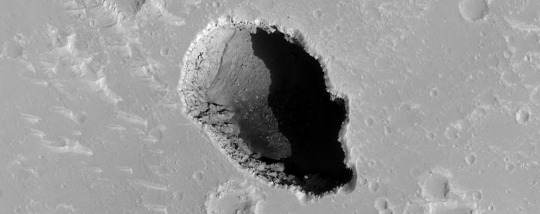
A Collapsed Martian Lava Chamber, Seen From Space
Lava tubes and chambers attract a lot of attention as potential sites for bases on the Moon and Mars. They provide protection from radiation, from temperature swings, and even from meteorites. They beg to be explored.
Volcanoes are just the most obvious and the largest manifestations of a planet’s volcanic activity. In reality, most of what creates a volcano happens deep underground. That’s true of Earth and Mars.
Volcanic activity can move an enormous amount of liquid rock, pushing it around and forming an interconnected network of lava tubes and chambers. The lava can drain away, leaving an empty cave or tube. Sometimes the roof collapses, forming what’s known as a skylight. There are many of them on the Moon, where they’ve attracted everyone’s attention. The skylight can provide easy access to what could be underground refuges in some cases.
Mars has them too, and NASA Mars Reconnaissance Orbiter (MRO) captured an image of one with its HiRISE camera.
It’s in the Hephaestus Fossae Region in Utopia Planitia on Mars. Hephaestus Fossae is a system of channels and troughs. It’s connected to the nearby Elysium volcanic center, and melt water from a nearby impact may have helped create it, too. There’s some uncertainty.
0 notes
